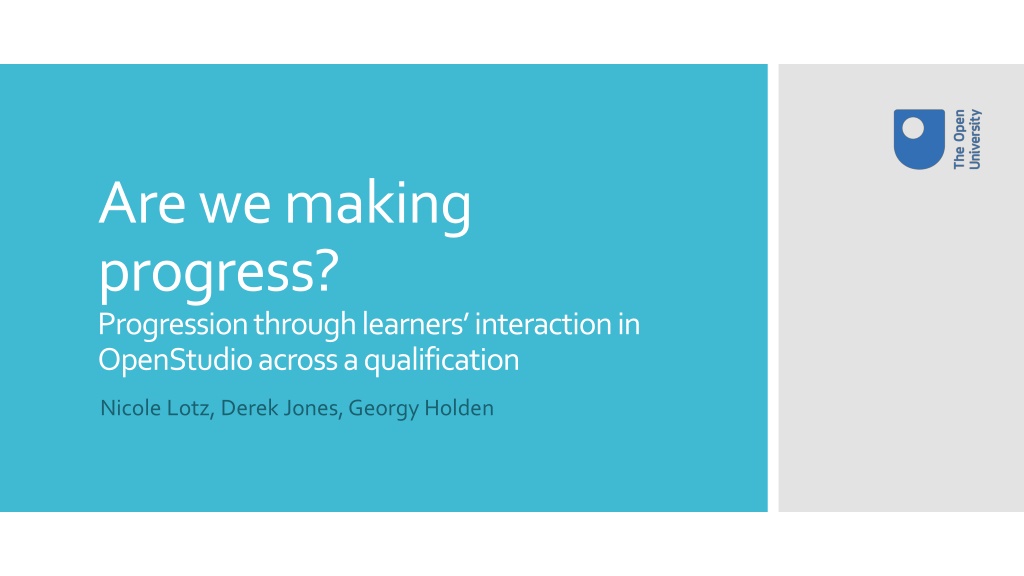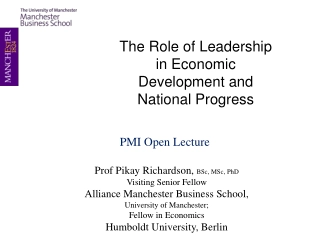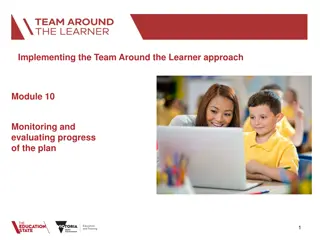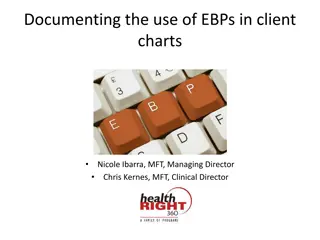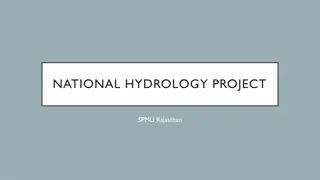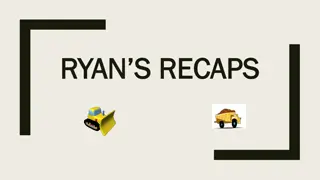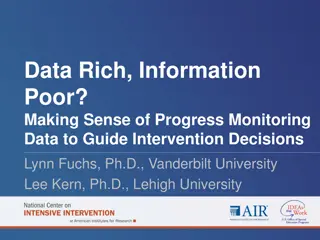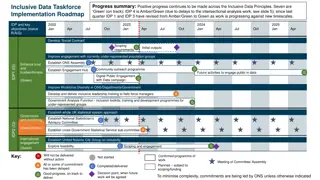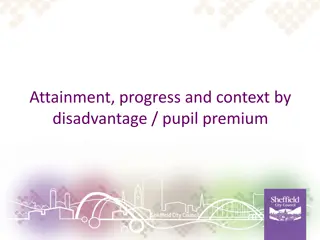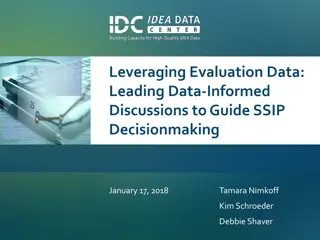Are we making progress?
The progression of learners in OpenStudio across a qualification through interactions and activities. The project aims to understand how engagement, communication, collaboration, knowledge, and learning skills evolve. The agenda includes discussions on traditional studio progression, factors influencing progression, activities in OpenStudio, and more. Key pedagogical approaches such as apprenticeship, simulation, and problem-based learning are highlighted.
Download Presentation

Please find below an Image/Link to download the presentation.
The content on the website is provided AS IS for your information and personal use only. It may not be sold, licensed, or shared on other websites without obtaining consent from the author.If you encounter any issues during the download, it is possible that the publisher has removed the file from their server.
You are allowed to download the files provided on this website for personal or commercial use, subject to the condition that they are used lawfully. All files are the property of their respective owners.
The content on the website is provided AS IS for your information and personal use only. It may not be sold, licensed, or shared on other websites without obtaining consent from the author.
E N D
Presentation Transcript
Are we making progress? Progression through learners interaction in OpenStudioacross a qualification Nicole Lotz, Derek Jones, Georgy Holden
Time 10:30-11:00 Topic Intro to Progression in OS project Traditional Studio progression What is progression in OS? Lead / activity Nic Derek All 11:00-11:40 Posters presentation and discussion: Statistics of engagement CAT Interviews ODS conversations Agenda: morning Derek Nic Georgy Nic Nic 11:40-12:30 Brainstorm factors for OS progression Cluster factors into Social, Technical, LD All 12:30-13:15 lunch
Time 13:15-14:15 Topic Progression in a Q Design three OS activities Lead / activity Georgy All 14:15-14:30 14:30-15:00 Tea/coffee Visioning activity Nic, All 15:00-15:30 New bids Project discussion Summary Nic All Nic Agenda: afternoon
Aim Understand how learners progress in OpenStudioas they move through the qualification. Progression of Engagement, Communication, Collaboration, Knowledge and Learning Skills. eSTEeM project Project builds on seminal paper: Lotz, Nicole;Jones, Derek andHolden, Georgina(2015).Social engagement in online design pedagogies.In:Proceedings of the 3rd International Conference for Design Education Researchers(VandeZande, Robin; Bohemia, Erik and Digranes, Ingvildeds.), Aalto University, pp. 1645 1668. 10:30-10:40
The signature pedagogy of design in a proximate studio includes : Apprenticeship that learning takes place with expert support Simulation it presents as close an experience to actual practice Progression in the traditional Design Studio Performative it is practice at behaving professionally Problem-based learning is constructivist/PBL : by design Output that a credible, realisable designed output is produced Semi-public it is performed, critiqued and judged amongst peers Social it enables social and pastoral support (recently identified) 10:30-10:40
Progression in a proximate studio : Apprenticeship (summative/hidden) that the master approves of the apprentice s activity and output Simulation (formative) that the student has put effort in; struggled; dealt with the difficulty of the design process Performative (summative) that the behaviours associated comply and won t compromise the profession (or safety ) Problem-based that design process led to a solution that is more creatively advanced than expected Output there is representation of a credible, realisable designed output is produced Semi-public that the student has performed competently in front of experts and peers Social (formative only!) that the student has made use of support and affective aspects of the studio, a community of learners and practitioners is emergent Progression in the traditional proximate Design Studio 10:30-10:40
Discuss: What is progression in OpenStudio context? From your experience of OpenStudio, what does progression mean? How does it relate, if at all, to the signature pedagogy of the proximate studio? 10:40-11:00
Progression in a OpenStudio : Apprenticeship Depends on tuition design and tutors. We have not really tried external experts in this space as yet. Simulation Hard to see in asynchronous studio most design modules use other methods (Compendium; Design Report) Performative Partially possible, e.g. the capable presentation of a design problem/solution Problem-based For shorter design activity (eg TMAs in U101) this is apparent since 100 s of students are on same problem Output Partially replicated final output is easy but students do report they wish to see more of other s processes Semi-public Replicated (possibly exceeded) for nearly all students, which is an incredible result considering OU students Social Replicated (exceeded?) for reasonable numbers of students this has significant potential. Community not continuous across Q s. Examples: What is progression in OpenStudio context? 10:40-11:00
Progression in OpenStudio is much more than subject affordances : Self-learning Far more than traditional proximate studios, OpenStudio requires design students to be self-reliant from very early in their learning journey. Good learning design can support this but do we know what a good ramp for this might be? Is it equitable? Examples: What is progression in OpenStudio context? Confidence and agency From the above comes student confidence and agency, developed through their own practice in the Studio. Does this level out? Can it be taken further? Social learning Even if they don t realise it is a ramp into collaboration. But how could this be developed further? Identity Can help support multiple identities known to support learning (e.g. as student; professional; subject student/expert). Digital literacies Could support the development of social media literacy, it already does, but it is not made explicit. 10:40-11:00
Work packages: Statistics CAT Interviews Workshop 11:00-11:40
Part 1: In small groups: Brainstorm factors for OS progression. (e.g. What OS features support students engagement and how?) Use post its or flip-chart Activity: OpenStudio progression factors Part 2: Cluster factors into Social, Technical, Learning Design. (they might overlap) Use Flip-chart Part 3: Present your discussion. 11:40-12:30
Social/LD Technical quick fun tasks generate critical mass for viewing a thing/visually stimulating visible on top layer Examples eSTEeM conference 2017 reward super commenters status or rating of helpfulness by others timeliness of activities fade or hide old posts relevant activities rate up relevance of an upload descriptions and comments interface guide description/comment tuition on OS identify as tutor assess OS posts highlight which are assessed 11:40-12:30
Time 13:15-14:15 Topic Progression in a Q Design three OS activities Lead / activity Georgy All 14:15-14:30 14:30-15:00 Tea/coffee Visioning activity Nic, All 15:00-15:30 New bids Project discussion Summary Nic All Nic Agenda: afternoon
Part 1: Individual or in small groups: Design three OS activities, one for each level (1-3) of a set of modules on a qualification that you are familiar with (or are planning). The activities should be designed to introduce the modules and the subjects they cover and encourage and develop continued use of OS across a qualification. Activity: Progression in a Qualification Part2: Present to all. 13:15-14:15
Activity: Visioning In your dreams in 5-10 years ahead what could an online studio be like? 14:30-15:00
eSTEeM: new scholarship to test hypotheses or practices, e.g. OS tuition JISC: reconnect? InnovateUK: funds industry academia - collaboration, take OS idea outside of OU. Business lead. Design foundations round 2 call just closed. Might be another one. Funding opportunities Nuffield: funds education transition research (more primary and secondary) New highlight: The impact of technology on social and economic outcomes, on skills necessary for the modern labour market, and on the wider issue of social relationships and personal identity in a data- driven economy and digital culture ERC: collaboration with European distance universities RCUK and Grand Challenges: taking OS into developing regions, ODA compliant relevant problem Next round of funding large cross-disciplinary and across SDG s 15:00-15:30
UNs SDGs 15:00-15:30
Project Structure Indicators of Achievement Means of Verification Risks and Assumptions Goal What are the wider objectives which the activity will help achieve? What is the longer term impact? What are the quantitative measures or qualitative judgements, whether these broad objectives have been achieved? What sources of information exist or can be provided to allow the goal to be measured? What external factors are necessary to sustain the objectives in the long run? Discuss: A hypothetical research or scholarship project Purpose What are the intended immediate effects of the project, what are the benefits, to whom? What improvements or changes will the project bring about? The essential motivation for undertaking the project. What sources of information exist or can be provided to allow the achievement of the purpose to be measured? What are the quantitative measures or qualitative judgements, by which achievement of the purpose can be judged? What external factors are necessary if the purpose is to contribute to achievement of the goal? What are the factors not in control of the project which are liable to restrict the outputs achieving the purpose? Outputs What outputs (deliverables) are to be produced in order to achieve the purpose? What kind and quality of outputs and by when will they be produced? (QQT: Quantity, Quality, Time) What are the sources of information to verify the achievement of the outputs? What are the sources of information to verify the achievement of the activities? Activities What activities must be achieved to accomplish the outputs? What kind and quality of activities and by when will they be produced? What factors will restrict the activities from creating the outputs? 15:00-15:30
Difficult to answer question if we are making progress in OS across the Q61 Design and Innovation qualification. Maybe we as learning designers need to be more aware of what progress we want student to make and allow students to recognise that, too. We know more and more about the diversity of uses of Online Studios, but we are not very skilled yet in developing effective and consistent learning designs across Q s Summary Tutor support as part of learning design in OS might be crucial. Controversial question: Are T317 students really doing so badly? Do they need a studio? Does OS need to be used throughout the Q? How does : One Design Authority come into this?
Additional Thoughts
ODS Shock. The population of T317 contains a large percentage of students who have not studied a module that uses ODS, perhaps suggesting that learning to use it at lower levels may be a requirement for successful use at higher levels. Experience from other modules making use of it, however, suggests that this is only partially true. Its use on A844 (a Masters level course) is successful but this does have introductory material between it and the predecessor course A843. Theories on why we re not making progress -1 Subject modes. The population of T317 contains a high number of students studying particular subjects that may not prefer the primarily social and active mode of learning required in ODS. Bridging modules. T217 may not be the needed bridge between U101 and T317; U101 might not be an appropriate foundation for such a bridge. The data shows that the use of ODS on T217 is very different, possibly due to the learning design itself but also the intensity of use (see weekly average and totals charts).
Interrupted flow. Students can study modules in any order they wish to and whilst there is some indication that many students study the 3 main design modules in order, other students will experience discontinuity of subject learning. This will mean they might not have continuous exposure to ODS perhaps meaning it becomes less central to their learning experience. Learning design. The design of individual activities may have a significant effect with the hypothesis that high use on U101 is thought to be due to: quick, fun, valuable, relevant and differentiable activities. This tends to be less in evidence on T317 where greater emphasis on analysis and text is the norm. This is a similar finding in (Thomas et al., 2016): The data suggest that students enjoy the OpenStudio activities, especially the visual nature of artefacts and the idea that shorter comments may be made, rather than longer more discursive pieces of writing. Visual interest. Closely aligned with Learning design is the visual interest generated by the activities. If this content is not interesting (primarily through visual attention) then the momentum required may not ne generated. Theories on why we re not making progress -2
We are certainly making progress in terms of knowledge of distance design education but there are clear differences between the use of ODS on the modules studied. From all the data analysed it is clear that ODS is used far less intensively in T317 and that when it is used it is less effective for the students using it. The module is perceived to be more theoretical in nature. Controversial question ? But are T317 students really doing so badly? Do they need a studio?
Rewarding Value (not pointless) Quick Fun Relevant (context) What makes a good OpenStudio activity ? Variation in output Balance between open/closed Needs tangible output -'a thing'
